#External data sources
Explore tagged Tumblr posts
Text
Interview Questions: External Objects
Interviewer: What is the use of External Objects Interviewee: When we need to show the data from the external sources without pulling the data actually into the salesforce org and just replication of the data on demand that’s when we can use the External objects. Interviewer: What is the pros and cons of Using External Objects Interviewee: Pros: 1. We can replicate the data securely from the…
View On WordPress
#Cross-Org#External Data sources#External Objects#OData#saleseforce#Salesforce#Salesforce Connect#Salesforce Connect Odata#Salesforce External Objects#trailhead
0 notes
Text
Working with APIs and Fetching Data from External Sources

View On WordPress
#API authentication#APIs#Best practices#Data Integration#Data Security#External data sources#JSON#Request handling#Web development#XML
0 notes
Text
antidepressants? no. doctors prescribed ketamine therapy + pair it with luke's entire discography on repeat
#fun fact though ketamine therapy works by making your brain more. plastic. it's a bit like psychadelics in a way#so (apparently. i haven't tried it yet SUPER inaccessible in australia (fans take note)) you work through your traumas in early sessions#and hey! i know exactly what albums to listen to during that process#then a lot of people journal and do talk therapy in between treatments for most effectiveness and later in the process#setting new habits while your brain is in flux!! a really good way of getting into what you know is good for you#so. i feel like i could do up like. a plan of 5sosverse albums for each week into ketamine therapy by now lmao#i did some external research but most of my data source for this is halsey and she is (obviously) Always Right#so obviously gotta throw in some halsey albums in there#anyway here's my science lesson of the day#depression#(implied at least)#ketamine therapy#luke hemmings#man it feels weird tagging it like that#just don't be weird about it#5 seconds of summer#5sos#ashton irwin#calum hood#michael clifford#boy ep#wfttwtaf
4 notes
·
View notes
Text
Unity Catalog: Unlocking Powerful Advanced Data Control in Databricks
Harness the power of Unity Catalog within Databricks and elevate your data governance to new heights. Our latest blog post, "Unity Catalog: Unlocking Advanced Data Control in Databricks," delves into the cutting-edge features
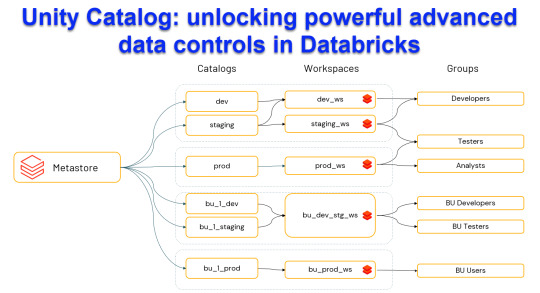
View On WordPress
#Advanced Data Security#Automated Data Lineage#Cloud Data Governance#Column Level Masking#Data Discovery and Cataloging#Data Ecosystem Security#Data Governance Solutions#Data Management Best Practices#Data Privacy Compliance#Databricks Data Control#Databricks Delta Sharing#Databricks Lakehouse Platform#Delta Lake Governance#External Data Locations#Managed Data Sources#Row Level Security#Schema Management Tools#Secure Data Sharing#Unity Catalog Databricks#Unity Catalog Features
0 notes
Text
Cockpit Exposure
There’s a terrible screeching of metal as your cockpit is rent open, exposed by a glancing blow from your opponents weapon. Suddenly your senses are muddled, two sources of data now vying for the attention of your shared mind. Your external cameras shift and refocus, as light streams in through the semi-transparent visor of your flight helmet.
Your partner is screaming in the back of your mind, and the terrible phantom pain in your chest tells you exactly why. It’s a huge strain on your mind to try and decipher between the information coming from your metal body, and the information coming from your flesh one. Your cockpit was designed to mimic a sensory deprivation chamber for this exact reason, most full-immersion frames are. The sensory deprivation of the pilot makes it easier to settle into the skin of the mech, fewer external distractions to remind you of your flesh body nestled under all that metal.
All of that is gone out the window now though, as the sounds and sights of combat assault your organic form through your breached cockpit. Distantly you recognize that you’re hyperventilating, and the safety systems are struggling to compensate. You guess this is because your partner’s panic is bleeding through the neural bridge. She did just get a huge chunk torn out of her front, after all.
With a monumental effort, you wrench control back from your panicking IMP, and you feel her systems settle down a bit as you enforce some order on things. The cold air and biting wind howling in your cockpit are doing all they can to distract you, but you’ve got a fight to finish and you’ll be damned if you end up gutted in your own cockpit.
Metal strains as your synthetic body stands and pulls the giant sword from the sheath on its back. You fire the boosters in your legs, feeling the g-forces slam your body back into the pilot’s seat as you charge your opponent. Blade strikes blade, and your damaged servos strain against theirs. A shot of fuel into your boosters breaks the stalemate and you pull back, circling around the opposing mech. You have to be extra careful to protect your cockpit now, one more hit to your chest and you’ll be pulp on your enemy’s blade.
Something shifts inside you, and you feel your IMP having off-loaded some of its processing into your wetware. She’s moving the limbs on your flesh body inside the cockpit, rooting around for something, piloting you the way you’re piloting her.
The lights on the front of your chassis flicker red in glee as you realize what she’s searching for. You send a mental acknowledgment over your shared link and hunch over, preparing for another bout. You’ll get your partner her opening.
According to regulation, mechs are required to have certain items stocked in their cockpits in case of emergency. Rations, a medical kit, an emergency radio, and most importantly: A flare gun. The standard flare gun had always seemed a bit superfluous to you, what difference is a meager flare going to make in spotting a 10-story tall Mech? But you’d convinced both your CO and your IMP to let you keep a few High-Explosive rounds for the thing stored alongside it, for a rainy day like today.
So the next time you clash with your opponent, blade grinding against blade, you feel your organic body move again. Your IMP makes use of the gaping hole in your chest, and manages to plant a high explosive round directly into the emergency hatch on your enemy’s chest, blowing it clean off, and disorienting their pilot in much the same way they had done to you only moments ago. You, however, will not squander this opportunity.
You drop your weapon, slam a hand through the breached hole in your opponents chest, and pulp the bleeding heart within it. The massive weapon of war you’ve been fighting slumps to the ground, the trauma of losing it’s organic half rippling through its systems. You grab the mech’s head and pull, metal screeching and cables snapping as you tear it free from the rest of the metal corpse. You find the glint of the enemy data core and crush it between two of your massive fingers, putting the enemy IMP out of its misery.
And suddenly it’s quiet again.
The faint sensation of wind upon skin echoes over the link, and you realize your IMP has removed your flight helmet. She’s half out of the pilot’s seat, and you can sense wonder radiating through the link as she looks out at the carnage through organic eyes. You decide to let her, regulation be damned.
You’re looking out at it through her eyes often enough, it’s only fair to return the favor.
#mechposting#writing#cybernetic dreams#microfiction#mecha#mech pilots#mech combat#IMPs are Mech AI#(Integrated Mechanical Personality)
287 notes
·
View notes
Text
SOURCE
Bit of a long video but worth a watch.
TL;DW though is that hidden in the Terms and Conditions for Google's AI Labs is a nice little poison pill that says they get access to your entire Google Drive if you opt in.
So if you're an author of some type and you keep your unpublished works in your G-Drive that means an AI will get to scrape all of it and by opting in you will have given them permission to it. The content creator goes on to predict that Google is going to let out their own streaming service where the scripts, and potentially the art if it's animated, will be almost or entirely AI generated using that scraped data as a baseline and the authors/artist's who's work was essentially stolen in its most raw form to crib from will have zero way of fighting Google on that in our current legal system.
This is of course right in the middle of the writers and actors strike where we're seeing just what lengths studios will go to in order to screw everyone but themselves.
They go on to recommend that if you keep any creative or personal works on Google Drive that you pull it off as soon as possible and delete your entire Drive. They acknowledge that of course this doesn't mean Google really deleted the data but if you do it before they start compulsory opting everyone in there's a chance your work might get overlooked. They also recommend several free editing programs that aren't run by corporations like Google with LibreOffice (the default office program of most Linux distros) being named.
Finally they go over methods of shaming Google which I feel like you just have to watch for comedies sake so I won't describe them in full.
Now this is from me: I know the majority of people don't have the ability to build and manage a big archive just for themselves, but if you're a creative NOW IS THE TIME to educate yourself on what you can do to protect your works. Cloud storage was always iffy at best, but with AI scraping entering the mix it's now downright malignant. Get a bunch of thumb drives, buy some external hard drives, if you have the money buy a pre-built NAS, and if you really want to get into learn how to build your own NAS. These are the old ways before cloud and they're coming back again, more important than ever.
#google#google docs#google drive#ai scraping#ai theft#ai generated theft#wga strike#wga solidarity#sag aftra#sag strike#libreoffice#google is cringe#delete your Google docs#embrace local back-ups
2K notes
·
View notes
Text
One of my favorite scenes in the whole series is after Murder bot has a catastrophic failure after fighting off the sentient killware in Exit Strategy. Part of the reason is obviously the Gurathin exchange
("oh thats gurathin... >:( ... I don't like you")
But the part that really gets me is when its struggling to reboot its memories and stumbles on a protected data package. And when it unravels it, it finds Sanctuary Moon. As soon as it hits play it, everything else begins to come flooding back in.
Just a few chapters ago it had told Mensa that Sanctuary Moon was its favorite because it was the first piece of media that it had seen after hacking its government module. Which was also where we start the series, which is also when Murderbot first began to make personal connections and decisions and decide what it liked and didn't like. And we see over and over again how it comes back to Sanctuary moon as a source of comfort and to shield itself from whats happening to it externally. But I don't know man, the way that Murderbot uses Sanctuary Moon to understands itself and its history, the way that it found comfort in the worst possible situations through a serial, and how that show has become not only a way to remember who it is, but also the things it cares about. After it unlocks Sanctuary Moon its able to recognize Gurathin, it recognizes the smile in Mensa's voice before it even remembers to open its eyes. It knows that Ratthi is its human friend, even if it finds it unlikely.
Maybe it's that Murderbot uses Sanctuary Moon the same way some of us (me, its me) use the Murderbot Diaries. Or maybe its that this is one of the most honest moments we have as Muderbot talks and thinks in the least filtered way we've ever seen. It just makes me tear up every time.
#murderbot diaries#murderbot#exit strategy#if you haven't listened to the audiobook version do it#cannot express how much i love it#so much#martha wells
329 notes
·
View notes
Text
What We Get Wrong About Dark Sonic

I find Dark Sonic incredibly interesting.
I’ve said this before, but Dark Sonic represents an overflow of Sonic’s negative emotions, the ones he usually suppresses: anger, sadness, and fear.
However, many people believe that Dark Sonic is somehow a betrayal of Sonic as a character (even Ian Flynn, reportedly, but I’ve yet to see an official source). Sonic is meant to be a beacon of optimism. Sonic is meant to be the pillar of hope when all else fails. Sonic is meant to be the last one standing, no matter what.
In this sense, sure, Dark Sonic contradicts the notion that Sonic is “uncorruptable,” but I think that depends on how we define corruption.
I see it two ways:
1) Corruption by way of losing faith, through dishonesty and fraud. 2) Corruption by way of a forceful shift from one state of being to another.
In the first sense, corruption occurs when someone’s paradigm is shifted through lies, cheating, or manipulation. It’s a conscious mental shift. In the second sense, corruption occurs when something (or someone) is co-opted and changed without its will or influence, like data corruption, or a shift in the meaning of a word or image. It’s a literal, physical and/or metaphysical shift.
There’s a saying that floats around the fandom that says, “Shadow is just ��Sonic, if Sonic had one really bad day’,” and I think that makes sense. Shadow is jaded and cynical because of how the world has hurt him, but he still wants to do right by people—just like Sonic. What separates Sonic from Shadow, however, is Sonic’s tenant optimism and positive paradigm. Without those differences, Sonic has endless reasons to be as cynical as Shadow, or even more so.
So, Sonic doesn’t let himself feel those feelings for very long, and especially not when other people are around. He pours everything into a clean, neat bottle, with a tight screw-on cap, right?
What happens when something tampers with that bottle?
Dark Sonic is a forceful corruption of body but not of mind. Let’s talk about it.
How Dark Sonic Works
What I think people misunderstand most about Dark Sonic is that it’s not an intentional state of being. It never was.
Dark Sonic is the polar opposite to Super Sonic, which is achieved when Sonic harnesses the positive energy of the Chaos Emeralds. If Sonic wanted to harness the power of the emeralds for the wrong reasons and his heart accessed the negative energy rather than the positive, he could possibly bring about Dark Sonic willingly. This, however, would likely never happen because that is the betrayal of Sonic’s character that everyone worries about.
That said, the only reason Dark Sonic ever appears is because of a mix of Sonic’s pure rage over Black Narcissist physically assaulting Chris and Cosmo and the presence of hundreds of the Metarex’s fake Chaos Emeralds, which possess an aura clearly shown to impact Sonic and make him ill.
Sonic’s first interaction with negative Chaos energy from the fake emeralds is filled with discomfort and even disgust. Sonic reacting to the negative Chaos energy poorly is critical, as it showcases that it’s seeking him out, not vice versa.

When Sonic was as triggered as he was, the negative energy from the fakes harnessed his emotions and corrupted him. It was a complete, freak accident.
This situation is very similar to Darkspine Sonic, the in-game equivalent to Dark Sonic from Sonic and the Secret Rings. Darkspine Sonic only surfaces when Sonic is severely triggered after Shahra starts to betray him, Erazor Djinn murders her (she sacrifices herself for Sonic), and he sees Erazor Djinn’s final form about to destroy the storybook world. In his shock and anger, the Secret Rings of Sadness, Rage, and Hate target him, painfully turning him into Darkspine Sonic. Once again, external energies corrupt him at the height of his emotional vulnerability.
Sonic never seeks out the negative energy of the Chaos Emeralds because his heart is good. When the negative energy seeks him out in such overwhelming waves, it corrupts his abilities, alters them, and pulls them out to play.
But—
If it’s simply a matter of fake Chaos Emeralds, then why can Sonic use Tails’ fake Chaos Emerald in Sonic Adventure 2 without any problems? I posit this to the fact that Tails might have a better understanding of the balanced nature of the Chaos Emeralds (in that they are powered by both good and evil), while Eggman and Dark Oak have only ever used (or desired to use) the Chaos Emeralds for evil.
Recall Eggman’s laser at the beginning of Sonic Unleashed and Perfect Chaos in Sonic Adventure. Both uses of the chaos emeralds drained them of their power—their negative power, that is. (Albeit through different means based on the lore of each game), Sonic is still able to restore and harness the emeralds’ power because he relies on the positive energy of the emeralds. As intelligent as he is, I imagine that Eggman (as well as the Metarex) has a hard time replicating the intricate nature and balance of the Chaos Emeralds because their hearts are filled with hatred and turmoil, so unwilling to heed the perspectives of others. The power is there, sure, but not the heart.
~Chaos is power. Power is enriched by the heart~
Tikal's Prayer
I think the difference between Tails’ fake emerald and every other fake emerald we’ve seen in canon is marked by the fact that both Eggman’s and the Metarex’s fakes disintegrate after excessive use (i.e., Chaos Control), but Tails’ fake remains intact.

The Metarex's emerald disintegrates upon excessive use
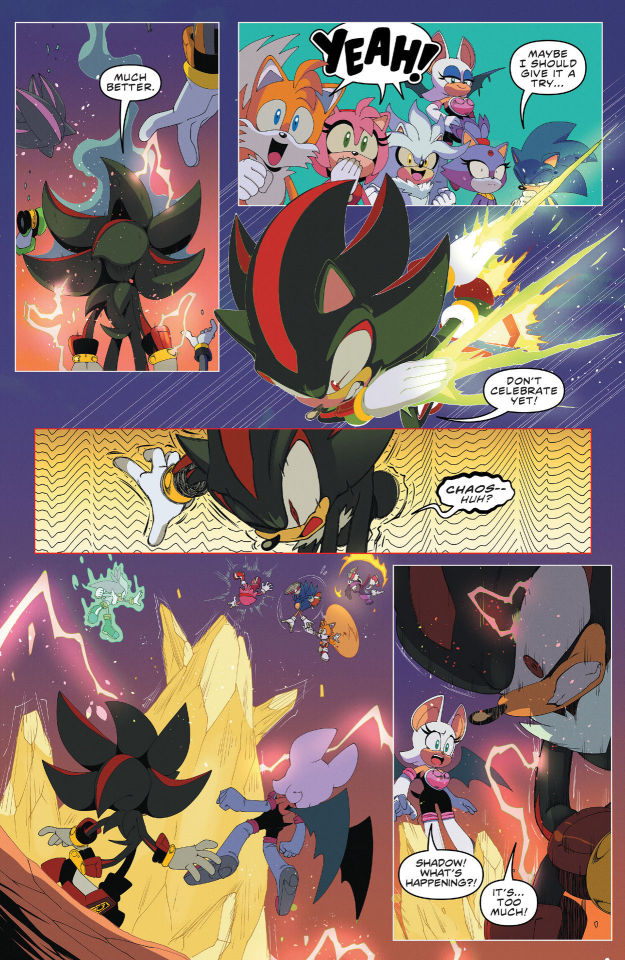

Eggman's fake emeralds can't hold their form upon excessive use
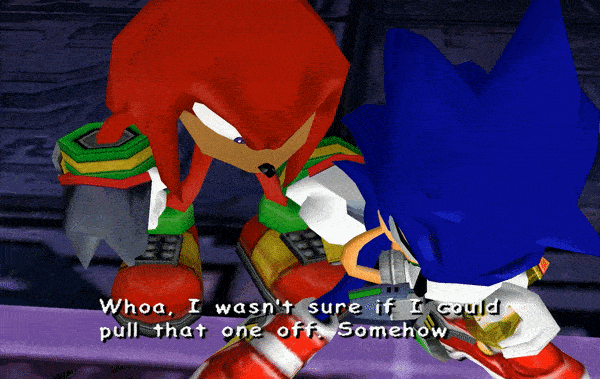
Tails' fake emerald is intact and ultimately used to stop the Eclipse Canon from firing
In short, Tails’ emerald is simply a better fake, more accurate to the originals.
also, I refuse to talk about how dumb it is that Sonic was able to use a fake Chaos Emerald to do Chaos Control for the first time. However, it is canon, and therefore relevant to my point.
Another key problem cited in Sonic X is just how many fake emeralds there are. One emerald pales in comparison to hundreds. Sonic feels all the latent negative energy consume him because that energy is a corruption, itself.
It’s not that Sonic gets so angry that he just gives in to darkness, it’s that darkness captures him when he’s in extreme emotional distress and his guard is down. Dark Sonic is the result of negative, unstable, potent Chaos energy clinging to him, using his latent Chaos powers as a vessel when he least expects it and, thus, is powerless against it.
I think I can best prove this by contrasting Dark Sonic with Sonic’s other intimate encounter with darkness…
Sonic Unleashed, Dark Gaia, and the Werehog
I’ve spoken at length about this game and this specific scene, already, so kindly forgive my hyper-brief summary this time around!
When Dark Gaia’s “weight issues” cause its essence to disperse around the globe, many people fall influence to Dark Gaia’s despair, losing faith and hope in the world. Nothing like the influences of Chaos energy, but enough of an influence that much of the world feels it. A core aspect of the game’s plot is that Sonic, distinctly, does not. In the cutscene No Reason, Sonic asks Chip why he stays the same despite the darkness inside his heart while so many others change at night. Chip answers simply, saying that Sonic’s too strong to lose himself and that part of his good will is because he never doubts himself, even when he’s on his own.
The difference is that while Sonic undergoes a physical transformation, he never loses faith or gives up hope—made especially clear by the fact that Professor Pickle, once as hopeful as Sonic, eventually does lose hope.

Also key to note that Amy also never loses hope.
Unleashed is just another fun, high-stakes adventure for Sonic; there’s never a moment where he’s aggressively triggered by something or when his personal morals are ever tainted. Irritated, maybe. Flustered, even. Never at a loss. The closest we see Sonic come to this is when he loses the werehog form to Dark Gaia before the final battle. He falls to his knees, worn and exhausted, and tells Chip to run because he doesn’t want him to get caught up in the mess. Yet even then he’s not giving up.
That’s why Sonic’s heightened emotional state is so important to the conversation. When Sonic’s will is intact, he’s much stronger, but when he’s triggered by something and his defences are down, it’s much easier for corrupting forces around him to take hold.
Mind over Matter
Even with the parameters for Dark Sonic’s appearance established, something that stands out to me about Sonic’s encounters with dark energies, and something I see as additional evidence that Dark Sonic is only a literal, physical corruption and not a corruption of his paradigm, is that Sonic is still in control of himself—to an extent.
Even as he seethes in his amplified rage, Dark Sonic never inflicts harm on the innocent. After Gold and Silver are destroyed, it’s not expressly clear if Sonic intends to stop or fight Black Narcissist, but Eggman implies that Sonic was fighting Gold and Silver until there was quite literally nothing left. Sonic was given a target to attack, and he kept his focus there, even when other enemies presented themselves.
This also goes for the Werehog and Darkspine Sonic.
He also has the mind to listen to reason—from Eggman, of all people—and stop when it’s clear that he’s finished what he set out to do. Sonic channels his anger to where it needs to be, and it’s clear that Sonic’s moral code and paradigm on life are thoroughly intact.

The only thing that changes is that he’s no longer imposing his usual limits. Sonic is stupidly powerful, even without any power ups. If he ever wanted to kill Eggman, he would have by now. If he ever wanted to kill anyone, he would have by now (and technically, he has).

Sonic throws Erazor Djinn's lamp into a pit, never to resurface, effectively trapping him and ending his livelihood indefinitely.
However, Sonic holds back because he doesn’t want to be an arbiter of justice—he doesn’t want to deprive someone’s chance to be good unless it’s been clear that they cannot be redeemed.
Why I Care About This
It is no secret that I believe that Sonic is a highly emotional character—far more emotional than many give him credit for. It bears repeating that Sonic’s emotions are very big and can be cataclysmic when left unchecked…
…but that’s just part of growing up—growing up as a hero and, damn it, even just a kid.
Dark Sonic isn’t a case of Sonic giving himself to darkness, nor is it a perversion of Sonic’s character. It’s an energetic, chaotically-charged version of Sonic when he is at his angriest—and even then it’s not enough to change his morals or make him lash out unjustly.
Dark Sonic is cathartic, in a way, and I definitely think it deserves its place in canon.

#sonic the hedgehog#sonic#sth#sonic character anlysis#dark sonic#in defense of#dr eggman#eggman#sonic x#sonic unleashed#sonic adventure#sonic adventure 2#sonic and the secret rings#chaos emeralds#chaos#perfect chaos#shadow the hedgehog#idw sonic#sonic idw#sonic idw spoilers#japanese sonic x#long post#:)#sonic the hedgehog needs a hug#sonic lore#sonic canon#molinaskies
2K notes
·
View notes
Text



Modeled another variant of case for Volna42BW
Fit WeAct 4.2' display; No bat
Few major updates in firmware v0.93 :
Added support for SCD41 sensor (CO2, Air Quality)
Added OpenWeather as external sensor data source
Project page
305 notes
·
View notes
Text

Mario Family was a Japan-only 2001 software for the Game Boy Color that was designed to let the console interface with a sewing machine via a special connection cable, enabling it to be used to send commands to the machine and let it sew Mario designs onto fabric.
Above is the data that the program sends to the machine to sew a Mario design, intercepted and recorded using external tools. The program sends eight different colored images, each causing the machine to sew parts of the pattern in that color, before finishing with the outline at the end.
Main Blog | Twitter | Patreon | Small Findings | Source
495 notes
·
View notes
Text
I don't think people responding to the scrambled "uh oh, we got caught" Tumblr AI announcement with "just nightshade and glaze all the art you post guys! it's your own fault if you don't do that small step! It's ok we'll get through this!" are Getting It:
Everything has already been scraped, including the account you haven't been able to access since 2015. Yes even the private, locked sideblogs of all your old art. Did you glaze it? did you nightshade it? in 2015? can you log in and check? no? Opted in.
This also includes any writing, creative or otherwise, posted to Tumblr. Did you nightshade the poetry and fanfiction you posted to Tumblr on your old account in 2018? why not? not a plan-aheader huh? Opted in!
It's opt in by default and by design. People who left Tumblr ages ago will likely not hear about this and won't know to regain account access and opt out. People who have died won't be able to log in and opt out. People who deleted past accounts or sideblogs won't be able to log in and opt out. People whose content is reposted here from Pixiv or other external sources by unrelated third parties won't have any way to say "hey half of that blog is MY stuff. Opt ME out."
Sorry. They just have everything ever put on the site. And you didn't opt out in 2015 when you lost access to your login email, so it's included. This is on purpose because they don't WANT people to be able to opt out, they want people to stay opted in saying "well my art sucks so I'm poisoning the data model 👍" while posting jokes and creative writing, they WANT you to say "well I'm unaffected" and keep posting photos and text and stuff. Midjourney wants that and Tumblr wants to do anything it can to satisfy Midjourney and scrape some cash out of that deal.
I'm sorry because I love this place too, but genuinely the decisions being made here are business decisions being put into place by a company trying to squeeze the last drops of blood out of a stone. Tumblr is not your friend. Staff is not your friend. Automattic is not your friend. The CEO has hopefully PROVEN he is not anyone's friend. This is a business first and a product that they are selling, not to you and me, but to advertisers and partners. Tumblr will ensure that Tumblr users see their ads and supply them data.
Frankly I do not trust this company or this website and I cannot in good faith just believe that they're going to look at my opt out checkbox and say "okay! ^_^ we will remove everything Dama has ever said or done from our AI scrape. we promise to do it!" and then actually do it. They already have the data. They can just claim that whatever is produced through machine learning based in part off of my data is unrelated, came from other sources, etc. I do not have trust in this website. I don't see how anyone could at this point.
I feel like I'm watching a trainwreck from the inside and no one wants to get out of their seats and try hopping off into the safe grassy field. Wait, they say. Let's see if the train just climbs back onto the tracks, they say. The fire and explosions are all part of the process, they say. Eventually people will stop panicking or dying and it'll be a smooth ride, they say. Just look at how bright the horizon is.
212 notes
·
View notes
Text
Yo, Welcome to my photography blog!
This is a photography project with a focus on older digital cameras sold before the mid 2000s. I've been working with these sorts of cameras since 2022, which grew from my interest in retro computers that I have had since 2020 or so. Here, I'll introduce you to my cameras, my computer rig, and try to convince you that this is a cool hobby.
General Q & A:
Whats in the name? - Kb refers to Kilobyte, all of the photos I take with these cameras only take up a little over 100 Kilobytes of digital storage per photo. FD refers to the physical media the photos are stored in, currently one camera uses floppy disks (FD), the other two use compact flash (CF) and smart media (SM) cards. unfortunately, their shortened forms do not rhyme and so they do not matter.
What can I expect from this blog? - amateur photography using old cameras, I guess. I'll say some nonsense below each photo but you're free to ignore it. I don't plan on reblogging anything here, so don't expect that. I am the star of this blog. me me me. I tend towards finding weird buildings/architecture, "liminal spaces", sunsets, and generally trying to see how well I can make a photo look like a blender render in a Kane pixels video. don't expect any consistency, though. the medium will remain the same but the vibes will absolutely fluctuate with my mood. I'll try and tag things correctly if it's off putting.
Are you a cool person? - I tend to be! I don't want this place to be alienating for anybody but assholes who don't deserve to see the stuff I do. being a tumblr blog, I follow a lot of the standard stuff. jerks are not welcome and I'm not gonna give you the pleasure of an argument if you do turn your head round these parts.
who are you? - trans pan girl. takes pictures. listens to Femtanyl. much unlike Peter Parker.
My Cameras
Mavica FD-7
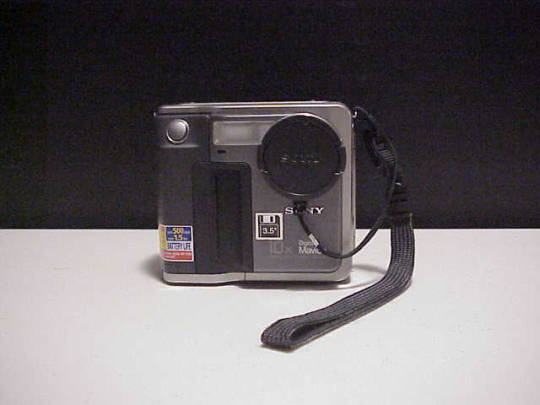

released in 1997, this was the second of Sony's "Digital Mavica" line of cameras. it records photos of around 50Kbs in size to a standard 3 1/2" floppy disk. it has some standard features like a manual focus wheel, 10x optical zoom, and exposure control. I haven't found a strict source but I believe this camera is less than one megapixel. I actually have a few different Mavica cameras (a fd-71/75/83/85/87 and a cd-1000) but they aren't different from the fd-7 enough to justify being used often. I'll make note on individual posts if I use 'em at all.
Kodak DC220


released in 1999, with a quality of exactly one megapixel the DC 220 is a weird little thing. it has custom software, connects to a computer via com ports with a transfer speed of ~11,000 bit/s. (roughly 30-60 seconds per photo in my experience) you can add custom text to your photos in the cameras built in software, and attach custom audio to each photo. it is a pain in the butt to get working, but it's quirks make it worth the frustration.
Olympus E-10


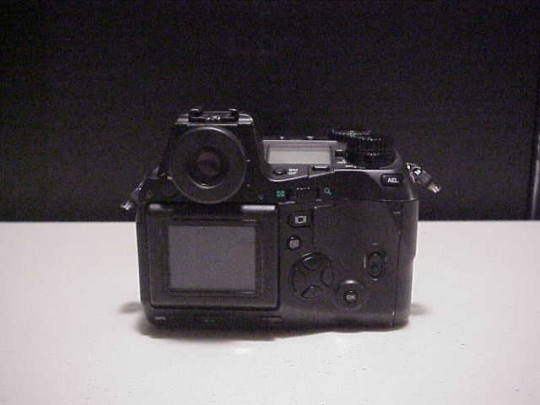
made in 2000 with a quality of a whopping four megapixels, the Olympus E-10 is the newest addition to my collection, and possibly the nicest camera I'll ever own. it's a fixed lens DSLR camera capable of 4x zoom, you can easily adjust the aperture and exposure on the fly, it's photos tend to be a whole 100kb in size (1/10th of a megabyte!) and to be entirely honest I have no idea how to use it. but I will eventually!
My Computer
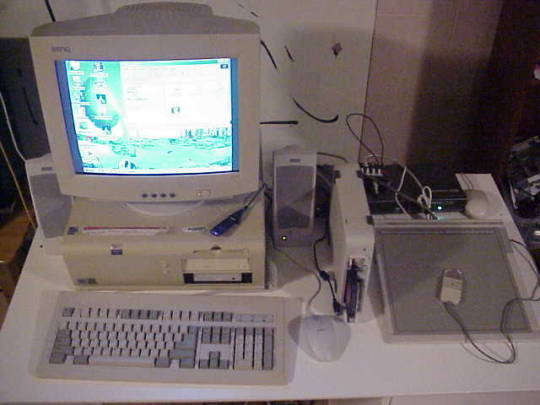
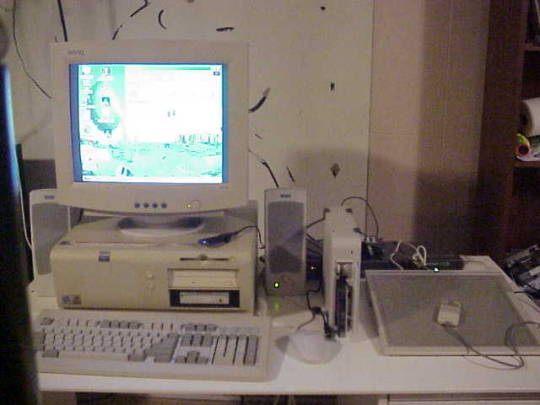

I try to use all era-appropriate tech to transfer photos and do any edits, this is the computer I do all that processing on! its a Dell Optiplex gx1- the daddy of pretty much any computer used in public schools (Chromebooks don't count) It's got a Pentium 3 CPU clocking at 500MHz, 512mb ram, running windows ME. it has all the original Kodak DC220 software installed, and I can't really access the Kodak's photos any other way. I've also got a few other weird bits attached to it -an HP sketch pro cad tablet and an external data cartridge SCSI device. both work, but I don't really bother to use them, they just look neat.
that's about it. have a good one! thanks for reading this all, if you did.
83 notes
·
View notes
Text
Pinging and Tapping
In the world of the Murderbot Diaries, communication is often conducted via comm and feed. Generally, comm is used when internal network is not available, or when one is trying to communicate across space, and feed is used when people are on the same network and allow each other access.
We also often see “pings” and “taps” as a way of quick communication.
Generally, pings are used for comm communications, and taps are used for feed communications, but there seem to be different purposes. Here are what we can gather from the story, and also from real life examples.
[Pings]
Purpose in the MB world:
Pings are typically used for signalling, checking connectivity, and getting responses from other systems or units. They act like a way to see if the other side is present and ready to communicate or respond.
Purpose in Real Life:
Network Connectivity: In computer networks, a "ping" is a diagnostic tool used to test the reachability of a host on an Internet Protocol (IP) network. It measures the round-trip time for messages sent from the originating host to a destination computer.
Usage in the MB World:
Status Checks: Used to check if systems, such as satellites, drones, or transports, are active and responsive. For example, pinging a satellite to see if it responds.
Communication Initiation: Used to start communication with other systems, often to establish a connection or share data. For instance, pinging a transport to offer media files in exchange for a ride.
Detection: Used by systems to detect the presence of specific units, like SecUnits, without direct contact.
Usage in Real Life:
ICMP Echo Request/Reply: The ping command sends an ICMP (Internet Control Message Protocol) Echo Request message to the target host and waits for an ICMP Echo Reply.
Network Troubleshooting: Used to determine if a particular host is reachable and to measure the latency between the source and destination.
[Taps]
Purpose in the MB World:
Taps are used more for internal communication within the network or feed. They serve as a means to acknowledge, signal actions, or provide private communication without verbal interaction.
Purpose in Real Life:
Internal Communication: In many systems, "taps" or similar mechanisms are used to signal and communicate internally within a network or system.
Usage in the MB World:
Acknowledgments: Used to acknowledge received messages or instructions. For instance, tapping back an acknowledgment to confirm receipt of instructions.
Private Communication: Used to send private or secure messages within the feed, often to communicate specific commands or information discreetly. For example, tapping the feed to communicate privately with another character without others listening in.
Control Signals: Used to signal or control actions within the feed, like tapping to instruct a character to fall back or take specific actions.
Usage in Real Life:
Signalling Mechanisms: Within computer systems, taps can be analogous to various signalling mechanisms like inter-process communication (IPC), which includes methods such as semaphores, shared memory, and message queues.
Acknowledgments and Control Signals: In networking, control signals and acknowledgments are crucial for managing data flow and ensuring reliable communication. For example, TCP (Transmission Control Protocol) uses acknowledgments to confirm the receipt of data packets.
Network Taps: In the context of network security, a "network tap" is a device that allows access to data flowing across a network for monitoring and analysis..
[Comparison]
In both the fictional world of Murderbot Diaries and real life, pings are primarily used for external signalling and connectivity checks, while taps are used for internal communication and control within the feed network
-------------------------------------------------
[Something Worth Noting]
There are some instances where taps seem more reasonable, but pings are used instead.
In Artificial Condition when Murderbot was watching Sanctuary Moon, and ART was trying to get its attention, asking to watch World Hoppers together. (see Artificial Condition, Pings, 5, 6 my AO3)
In Network Effect, when Murderbot finds that a hostile vessel (i.e. ART) was approaching and notifies the team quickly (see Network Effect, Pings, 1 my AO3)
In Network Effect, when Murderbot was locking itself up in the bathroom (see Network Effect, Pings, 11, 12 my AO3)
In Network Effect, when ART requested a private connection (see Network Effect, Pings, 13 my AO3)
In Network Effect, when Amena comes along with Murderbot to investigate Barish-Estranza shuttle, but is told to wait outside. She offers to help to which Murderbot pings acknowledgement (see Network Effect, Pings, 14 my AO3)
At the end of System Collapse when Murderbot pinged Three to ask if it wanted to listen to Holism explain planetary infrastructure (see System Collapse, Pings 15 my AO3)
Of these, 1, 3, 4 are where ART was sending pings to Murderbot. This is actually quite sweet, because we can tell that ART is being very polite to Murderbot. ART is fully capable of slamming into Murderbot’s private feed, but in all of these occasions, Murderbot has been rejecting feed communication which it reserves for friends and clients. ART is respecting this.
Instance 2 is unusual, and I am not 100% sure why Murderbot chose to use ping here. But since it was emergency, and ping is a protocol where it receives automatic response if it had been received at the other end, it was sufficient for its purposes.
When we read the context in which 5 happens we notice that Murderbot is now inside the B-E shuttle, and for security reasons, ART had cut it off from the feed network. So, Murderbot has the options of either verbally answering to Amena, or sending a ping for acknowledgement, and it chose the latter.
In instance 6, Murderbot seems to be being polite to Three who is busy (?) watching educational media. They are cordial to each other, but because Three is still not used to being a free SecUnit, Murderbot is being more careful around it.
--------------
If you are willing to be bored to death, you can see my AO3 post for the list of all the instances where pinging and tapping happen!
60 notes
·
View notes
Text
Reverse 1999 Theory: What is "Perception" and how does it work in arcanists?
Vertin canonically has uncanny perception and a deep understanding for arcanum even amongst arcanists, despite her lack of skill. Arcanists are very sensitive, or rather, vulnerable to emotions. There is another arcanist known for her perception we can look at for more clues.
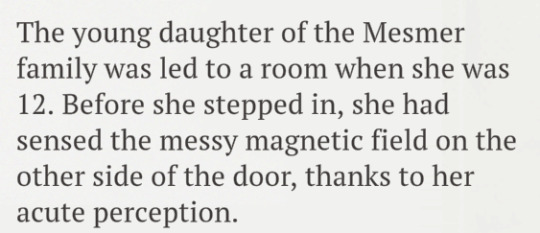
Mesmer Jr. also has a "acute perception", much like Vertin.
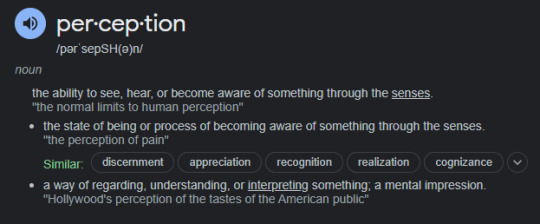
In Reverse 1999, Perception functions like a 6th sense in arcanists. But how does it work? I looked up to see if there is a connection between magnetic fields and emotions. Turns out there is A LOT. Specifically the magnetic field radiated by the heart.
Biomagnetic Communication Between People (source).
We have found there is a direct relationship between the heart-rhythm patterns and the spectral information encoded in the frequency spectra of the magnetic field radiated by the heart. Thus, information about a person’s emotional state is encoded in the heart’s magnetic field and is communicated throughout the body and into the external environment.
There is so much cool information in this article I'd love to gush about, but we're here for lore. Remember my psychube post that I never shut up about? It's actually missing very important information that I didn't add at the time because I could not figure out how it worked.
Polarization:



The different frequencies are triggered by different kinds of emotions and we can see the heart being affected by the electromagnetic fields. My theory is that this is the key to arcanist perception. This is how they "sense" emotions. They are picking up on these frequencies. For a real life example from the same article, look at these graphs showing how the influence of emotions:

Most people tend to think of communication solely in terms of overt signals expressed through facial movements, voice qualities, gestures and body movements. However, evidence now supports the perspective that a subtle yet influential electromagnetic or "energetic" communication system operates just below our conscious level of awareness. The following section will discuss data that suggests this energetic system contributes to the "magnetic" attractions or repulsions that occur between individuals.
Arcanists sense these waves and it can cause distress in them. Mesmer Jr. is a prime example of this. Other people's emotions get to her.
Now how does this tie into our beloved Timekeeper?
What if the reason Vertin has to stay "stoic" is because her emotions can influence the others around her and because she is extra susceptible to other people's incoming emotions. She needs to stay calm even in mental distress. Mesmer Jr. is also like this. She may come off as abrasive and snappy at times but she is described as a "an indifferent and refined machine" (Chapter 3: An Opened Sandwich). These two share a lot in common. They are both victims of trauma yet must operate in many emotionally taxing positions.
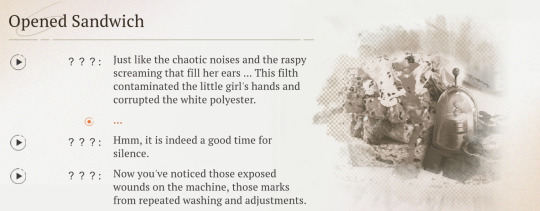
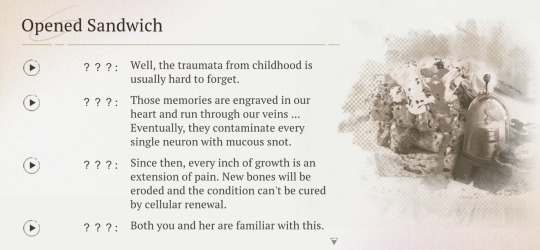
They even say "engraved in the heart" (although this could simply be word choice it really fits)!
Both Vertin and Mesmer Jr. struggle everyday to keep the their feelings at bay. Neither of them is "used" to this life but they have to keep up the facade for their sake and possibly for those around them.
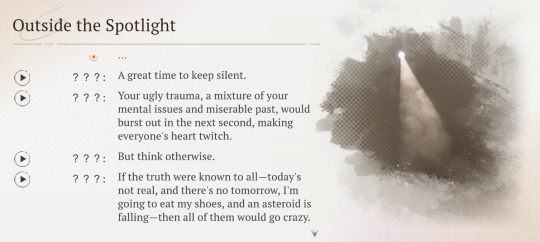
The main story doesn't give us as much insight into Vertin's head but the traces do. She is always holding back, just like Mesmer.
Side note, do you remember the heartbeat we heard as Schneider was reversed? It raced. Interesting how later Schneider shows up in one of her dreams during Artificial Somnambulism. This could be an example of HF Polarization which generates strong and temporary mental images with very powerful emotions.
This also adds an extra layer to Vertin's interactions with others. She tried to get through to Druvis and Schneider, but as for Forget-me-not and Arcana, she didn't bother. Maybe their feelings of revenge and hatred are so tangible she knew it was lost cause. However, Druvis was laden with grief and loss. She was not a malicious person. Schneider was desperate and motivated by love for her family. Vertin even mentions she knew Madam Z was not part of Constantine's game by the "look in her eyes" and never blamed her for the loss of her friends.
If anything seems wrong or if I missed something, please let me know! I'd be happy if I could refine it further.
#reverse 1999#vertin#mesmer jr#reverse 1999 lore#character analysis#psychube#i think i got something big here#but its still theory lol#i also learned cool science stuff#reverse 1999 theory
186 notes
·
View notes
Photo

Desert Kites
Desert Kites are mega-constructions that consist of two long walls converging upon an enclosed space that has on its periphery small stone constructions called cells. Seen from the sky, their shape suggests that of a windborne kite; they were thus called kites by pilots who flew over the arid regions of the Near East in the time of the French and British mandates of the first half of the 20th century CE. These kites combine various characteristics which in archaeology have been the object of particular research. However, most classical methods of investigation are useless because of the nature of these constructions.
In spite of many studies, kites remain a mystery in many respects, although recent research has advanced their knowledge. We are beginning to better understand their geographic extension, their age and their function, crucial questions still under discussion a short time ago. From the beginning of the 2010s CE, the access to high-resolution satellite images stimulated research by revealing that there are many more kites than were thought a few years ago. From this new data source and more classical information, multidisciplinary investigations were launched in conjunction with the organization of field expeditions.
Morphological Description
Kites are large archaeological remains, generally quite well preserved. They are dry stone constructions, composed of an enclosure and more or less continuous walls which converge towards an entrance; these walls can sometimes be absent but are usually two in number and sometimes three, four or more. Their length is commonly several hundred meters and can even reach several kilometres, while their height is no more than a few decimetres. The enclosures are variable in shape (circular, triangular, star-shaped, etc.) and their size, far larger than pastoral enclosures, varies from a few hundred square meters to more than ten hectares.
The small stone constructions or cells that are joined to the external part of the enclosure are the most sophisticated part of the device, always carefully constructed. Their number varies from a single cell to several dozen. The variability among the kites makes it difficult to propose a typology. Several often-observed attributes are considered, such as a disposition of the cells near the entrance, the existence of cells at the extremity of pointed appendices and the particular shapes of the entrance. These features are most often shared by kites from the same region, thus forming homogeneous groups circumscribed at the regional scale. Kites are found in arid environments, steppes and desert margins and their topographical location is clearly the result of a definite choice. A break in the slope is the most often observed at the position of the entrance and various topographic configurations were preferred to flat topography.
Continue reading...
31 notes
·
View notes
Text

The Radio Sky: Tuned to 408MHz - November 26th, 1996.
"Tune your radio telescope to 408MHz (408 million cycles per second) and check out the radio sky! In the 1970s, large dish antennas at three radio observatories, Jodrell Bank, MPIfR, and Parkes Observatory, were used to do just that - the data was combined to map the entire sky. Near this frequency, cosmic radio waves are generated by high energy electrons spiraling along magnetic fields. In the resulting false-colour image, the galactic plane runs horizontally through the center, but no stars are visible. Instead, many of the bright sources near the plane are distant pulsars, star forming regions, and supernova remnants, while the grand looping structures are pieces of bubbles blown by local stellar activity. External galaxies like Centaurus A, located above the plane to the right of the center, and the LMC (below and right) also shine in the radio sky."
26 notes
·
View notes